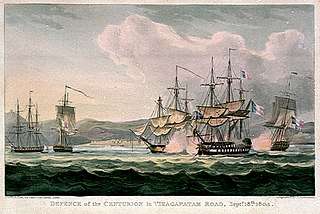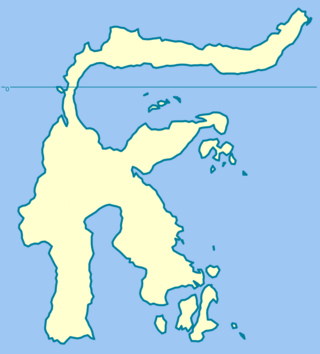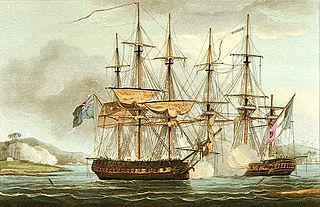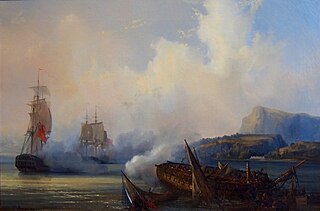
The Mauritius campaign of 1809–1811 was a series of amphibious operations and naval actions fought to determine possession of the French Indian Ocean colonies of Isle de France and Isle Bonaparte during the Napoleonic Wars. The campaign lasted from the spring of 1809 until the spring of 1811, and saw both the Royal Navy and the French Navy deploy substantial frigate squadrons with the intention of disrupting or protecting trade from British India. In a war in which the Royal Navy was almost universally dominant at sea, the campaign is especially notable for the local superiority enjoyed by the French Navy in the autumn of 1810 following the British disaster at the Battle of Grand Port, the most significant defeat for the Royal Navy in the entire conflict. After their victory, the British used the original Dutch name of Mauritius for Isle de France. In 1814, Isle Bonaparte was returned to France, who eventually renamed it La Réunion.

Pierre-François-Henri-Étienne Bouvet de Maisonneuve was a French Navy officer and privateer.

Jean-Jacques Rousseau was a Téméraire class 74-gun ship of the line of the French Navy, active during the French Directory, French Consulate and First French Empire. Renamed Marengo in 1802, she took part in Linois' operations in the Indian Ocean before her capture by the Royal Navy.

Linois's expedition to the Indian Ocean was a commerce-raiding operation launched by the French Navy during the Napoleonic Wars. Contre-Admiral Charles-Alexandre Durand Linois was ordered to the Indian Ocean in his flagship Marengo in March 1803 accompanied by a squadron of three frigates, shortly before the end of the Peace of Amiens. When war between Britain and France broke out in September 1803, Marengo was at Pondicherry with the frigates, but escaped a British squadron sent to intercept it and reached Isle de France. The large distances between naval bases in the Indian Ocean and the limited resources available to the British commanders in the region made it difficult to concentrate sufficient forces to combat a squadron of this size, and Linois was subsequently able to sustain his campaign for three years. From Isle de France, Linois and his frigates began a series of attacks on British commerce across the Eastern Indian Ocean, specifically targeting the large convoys of East Indiamen that were vital to the maintenance of trade within the British Empire and to the British economy. Although he had a number of successes against individual merchant ships and the small British trading post of Bencoolen, the first military test of Linois squadron came at the Battle of Pulo Aura on 15 February 1804. Linois attacked the undefended British China Fleet, consisting of 16 valuable East Indiamen and 14 other vessels, but failed to press his military superiority and withdrew without capturing a single ship.

The Battle of Vizagapatam was a minor naval engagement fought in the approaches to Vizagapatam harbour in the Coastal Andhra region of British India on the Bay of Bengal on 15 September 1804 during the Napoleonic Wars. A French squadron under Contre-Admiral Charles-Alexandre Léon Durand Linois in the ship of the line Marengo attacked the British Royal Navy fourth rate ship HMS Centurion and two East Indiaman merchant ships anchored in the harbour roads. Linois was engaged in an extended raiding campaign, which had already involved operations in the South China Sea, in the Mozambique Channel, off Ceylon and along the Indian coast of the Bay of Bengal. The French squadron had fought one notable engagement, at the Battle of Pulo Aura on 15 February 1804, in which Linois had attacked the Honourable East India Company's (HEIC) China Fleet, a large convoy of well-armed merchant ships carrying cargo worth £8 million. Linois failed to press the attack and withdrew with the convoy at his mercy, invoking the anger of Napoleon when the news reached France.

Admiral Sir Fleetwood Broughton Reynolds Pellew CB KCH was an officer of the Royal Navy who served during the French Revolutionary and Napoleonic Wars.

The Atlantic campaign of 1806 was a complicated series of manoeuvres and counter-manoeuvres conducted by squadrons of the French Navy and the British Royal Navy across the Atlantic Ocean during the spring and summer of 1806, as part of the Napoleonic Wars. The campaign followed directly from the Trafalgar campaign of the year before, in which the French Mediterranean fleet had crossed the Atlantic, returned to Europe and joined with the Spanish fleet. On 21 October 1805, this combined force was destroyed by a British fleet under Lord Nelson at the Battle of Trafalgar, although the campaign did not end until the Battle of Cape Ortegal on 4 November 1805. Believing that the French Navy would not be capable of organised resistance at sea during the winter, the First Lord of the Admiralty Lord Barham withdrew the British blockade squadrons to harbour. Barham had miscalculated – the French Atlantic fleet, based at Brest, had not been involved in the Trafalgar campaign and was therefore at full strength. Taking advantage of the reduction in the British forces off the port, Napoleon ordered two heavy squadrons to sea, under instructions to raid British trade routes while avoiding contact with equivalent Royal Navy forces.

The action of 9 July 1806 was a minor engagement between a French privateer frigate and British forces off Southern Ceylon during the Napoleonic Wars. French privateers operating from the Indian Ocean islands of Île Bonaparte and Île de France were a serious threat to British trade across the Indian Ocean during the Wars, and the British deployed numerous methods of intercepting them, including disguising warships as merchant vessels to lure privateers into unequal engagements with more powerful warships. Cruising near the Little Basses Reef on the Southern coast of Ceylon, the 34-gun privateer Bellone was sighted by the 16-gun British brig HMS Rattlesnake, which began chasing the larger French vessel. At 15:15, a third ship was sighted to the south, which proved to be the 74-gun ship of the line HMS Powerful, disguised as an East Indiaman.
Admiral Sir Lawrence William Halsted GCB was an officer of the Royal Navy who served during the American War of Independence and the French Revolutionary and Napoleonic Wars.

The action of 26 July 1806 was a minor naval engagement of the Napoleonic Wars fought off the southern coast of the island of Celebes in the Dutch East Indies. During the battle, a small British squadron attacked and defeated a Dutch force defending a valuable convoy, which was also captured. The British force—consisting of the frigate HMS Greyhound and brig-sloop HMS Harrier under the command of Captain Edward Elphinstone—was initially wary of the Dutch, mistaking the Dutch East Indiaman merchant ship Victoria for a ship of the line. Closer observation revealed the identity of the Dutch vessels the following day and Elphinstone led his frigate against the leading Dutch warship Pallas while Harrier engaged the merchant vessels and forced them to surrender. Only the corvette William escaped, taking no part in the engagement.

The Java campaign of 1806–1807 was a minor campaign during the Napoleonic Wars by British Royal Navy forces against a naval squadron of the Kingdom of Holland, a client state of the French Empire, based on the island of Java in the Dutch East Indies. Seeking to eliminate any threat to valuable British merchant convoys passing through the Malacca Straits, Rear-Admiral Sir Edward Pellew determined in early 1806 that the Dutch naval forces based at Java, which included several ships of the line and three frigates, had to be defeated to ensure British dominance in the region. Lacking the forces to effect an invasion of the Dutch colony, Pellew instead sought to isolate and blockade the Dutch squadron based at Batavia in preparation for raids specifically targeting the Dutch ships with his main force.

The Raid on Batavia of 27 November 1806 was a successful attempt by a large British naval force to destroy the Dutch squadron based on Java in the Dutch East Indies that posed a threat to British shipping in the Straits of Malacca. The British admiral in command of the eastern Indian Ocean, Rear-Admiral Sir Edward Pellew, led a force of four ships of the line, two frigates and brig to the capital of Java at Batavia, in search of the squadron, which was reported to consist of a number of Dutch ships of the line and several smaller vessels. However the largest Dutch ships had already sailed eastwards towards Griessie over a month earlier, and Pellew only discovered the frigate Phoenix and a number of smaller warships in the bay, all of which were driven ashore by their crews rather than engage Pellew's force. The wrecks were subsequently burnt and Pellew, unaware of the whereabouts of the main Dutch squadron, returned to his base at Madras for the winter.
The Raid on Griessie was a British attack on the Dutch port of Griessie on Java in the Dutch East Indies in December 1807 during the Napoleonic Wars. The raid was the final action in a series of engagements fought by the British squadron based in the Indian Ocean against the Dutch naval forces in Java. It completed the destruction of the Dutch squadron with the scuttling of three ships of the line, the last Dutch warships in the region. The British squadron—under the command of Rear-Admiral Sir Edward Pellew—sought to eliminate the Dutch to safeguard the trade route with China, which ran through the Straits of Malacca and were in the range of Dutch raiders operating from the principal Javan port of Batavia. In mid-1806, British frigates reconnoitred Javan waters and captured two Dutch frigates, encouraging Pellew to lead a major attack on Batavia that destroyed the last Dutch frigate and several smaller warships. Before the Batavia raid, Dutch Rear-Admiral Hartsinck had ordered his ships of the line to sail eastwards, where they took shelter at Griessie, near Sourabaya.

The Battle of Mahé was a minor naval engagement of the last year of the French Revolution, fought on 19 August 1801 in the harbor of Mahé in the Seychelles, a French colony in the Indian Ocean. Since the demise of the French Indian Ocean squadron in 1799, the Royal Navy had maintained dominance in the East Indies, controlling the shipping routes along which trade flowed and allowing the rapid movement of military forces around the theatre. French First Consul Napoleon Bonaparte had long-harboured ambitions of threatening British India, and in 1798 had launched an invasion of Egypt as an initial step to achieving this goal. The campaign had failed, and the French army in Egypt was under severe pressure by early 1801, partly due to the presence of a British squadron acting with impunity in the Red Sea.

The East Indies theatre of the French Revolutionary Wars was a series of campaigns related to the major European conflict known as the French Revolutionary Wars, fought between 1793 and 1801 between the new French Republic and its allies and a shifting alliance of rival powers. Although the Indian Ocean was separated by vast distance from the principal theatre of the conflict in Western Europe, it played a significant role due to the economic importance of the region to Great Britain, France's most constant opponent, of its colonies in India and the Far Eastern trade.

The Macau Incident was an inconclusive encounter between a powerful squadron of French and Spanish warships and a British Royal Navy escort squadron in the Wanshan Archipelago off Macau on 27 January 1799. The incident took place in the context of the East Indies campaign of the French Revolutionary Wars, the allied squadron attempting to disrupt a valuable British merchant convoy due to sail from Qing Dynasty China. This was the second such attempt in three years; at the Bali Strait Incident of 1797 a French frigate squadron had declined to engage six East Indiamen on their way to China. By early 1799, the French squadron had dispersed, with two remaining ships deployed to the Spanish Philippines. There the frigates had united with the Spanish Manila squadron and sailed to attack the British China convoy gathering at Macau.

The invasion of the Spice Islands was a military invasion by British forces that took place between February and August 1810 on and around the Dutch owned Maluku Islands also known as the Spice Islands in the Dutch East Indies during the Napoleonic wars.

HMS Caroline was a 36-gun fifth-rate Phoebe-class frigate of the Royal Navy. She was designed by Sir John Henslow and launched in 1795 at Rotherhithe by John Randall. Caroline was a lengthened copy of HMS Inconstant with improved speed but more instability. The frigate was commissioned in July 1795 under Captain William Luke to serve in the North Sea Fleet of Admiral Adam Duncan. Caroline spent less than a year in the North Sea before being transferred to the Lisbon Station. Here she was tasked to hunt down or interdict French shipping while protecting British merchant ships, with service taking her from off Lisbon to Cadiz and into the Mediterranean Sea. In 1799 the ship assisted in the tracking of the French fleet of Admiral Étienne Eustache Bruix, and in 1800 she participated in the blockade of Cadiz.

Captain Peter Rainier was a Royal Navy officer of the eighteenth and nineteenth centuries. Due to the patronage of his uncle, Vice-Admiral Peter Rainier, he was promoted quickly through the ranks so that by the age of twenty he was already a captain. He was given command of the 36-gun frigate HMS Caroline and on 18 October 1806 he fought a successful action in her against the Dutch 36-gun frigate Maria Reijersbergen at Batavia.
Rear-Admiral Sir John Marshall was a Royal Navy officer. Having joined the navy in 1800, he fought at the Raid on Batavia as a lieutenant in 1806 and was promoted to commander in 1812 while serving at the Siege of Riga. He was given a command on the East Indies Station and took passage there on HMS Java. Java was captured by USS Constitution in December and Marshall was unable to assume command. Subsequently released in a prisoner exchange, he was instead given command of HMS Shamrock in 1813. In December he was given command of a squadron of gunboats in the North Sea to assist in the attack and capture of Glückstadt, which was completed on 5 January.

















